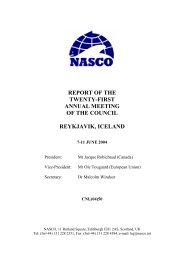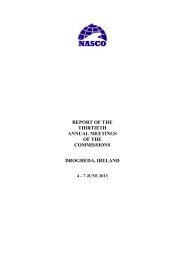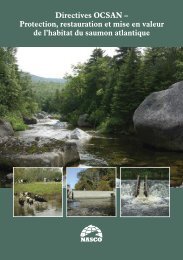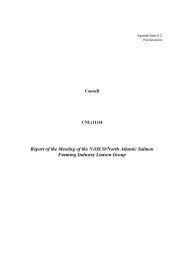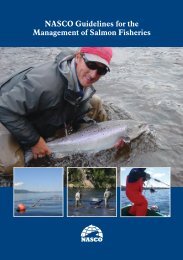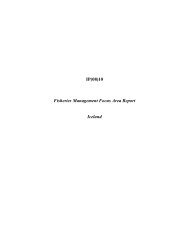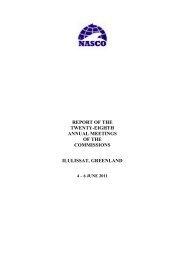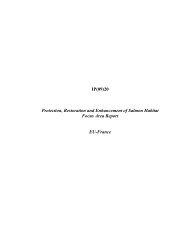Report of the 2005 ICES/NASCO Symposium on Interactions ...
Report of the 2005 ICES/NASCO Symposium on Interactions ...
Report of the 2005 ICES/NASCO Symposium on Interactions ...
You also want an ePaper? Increase the reach of your titles
YUMPU automatically turns print PDFs into web optimized ePapers that Google loves.
NINA SPECIAL REPORT 34<br />
native species was also found to increase as a result <str<strong>on</strong>g>of</str<strong>on</strong>g><br />
escapees predating <strong>on</strong> native species and an increase in<br />
marine birds near farms. The use <str<strong>on</strong>g>of</str<strong>on</strong>g> a <str<strong>on</strong>g>the</str<strong>on</strong>g>oretical model<br />
comparing populati<strong>on</strong>s exposed to salm<strong>on</strong> farming to<br />
those not exposed identified a reducti<strong>on</strong> in productive<br />
capacity <str<strong>on</strong>g>of</str<strong>on</strong>g> up to 1% per t<strong>on</strong>ne <str<strong>on</strong>g>of</str<strong>on</strong>g> producti<strong>on</strong> in <str<strong>on</strong>g>the</str<strong>on</strong>g> areas<br />
studied. An increase in predati<strong>on</strong> <strong>on</strong> salm<strong>on</strong> as a result <str<strong>on</strong>g>of</str<strong>on</strong>g><br />
a successful restorati<strong>on</strong> programme for ano<str<strong>on</strong>g>the</str<strong>on</strong>g>r<br />
anadromous species emphasized <str<strong>on</strong>g>the</str<strong>on</strong>g> importance <str<strong>on</strong>g>of</str<strong>on</strong>g><br />
thinking <str<strong>on</strong>g>of</str<strong>on</strong>g> <str<strong>on</strong>g>the</str<strong>on</strong>g> entire ecosystem.<br />
Management <str<strong>on</strong>g>of</str<strong>on</strong>g> Interacti<strong>on</strong>s<br />
Increased reporting <str<strong>on</strong>g>of</str<strong>on</strong>g> escapees was identified as a<br />
positive development. <str<strong>on</strong>g>Report</str<strong>on</strong>g>ing <str<strong>on</strong>g>of</str<strong>on</strong>g> all escapees and<br />
causes is required in Norway and o<str<strong>on</strong>g>the</str<strong>on</strong>g>r countries.<br />
Interacti<strong>on</strong>s between vessels and cages were identified as<br />
a significant cause <str<strong>on</strong>g>of</str<strong>on</strong>g> escapees and <str<strong>on</strong>g>the</str<strong>on</strong>g> simple soluti<strong>on</strong> <str<strong>on</strong>g>of</str<strong>on</strong>g><br />
requiring radar reflectors and updating navigati<strong>on</strong>al charts<br />
was identified. The Nati<strong>on</strong>al Acti<strong>on</strong> Plan in Norway is<br />
designed to prevent escapees (staff competence,<br />
informati<strong>on</strong> and educati<strong>on</strong>, envir<strong>on</strong>mental management<br />
systems). In additi<strong>on</strong>, new certificati<strong>on</strong> requirements in<br />
Norway require capability assessments to ensure that <str<strong>on</strong>g>the</str<strong>on</strong>g><br />
equipment at a farm is matched to <str<strong>on</strong>g>the</str<strong>on</strong>g> site c<strong>on</strong>diti<strong>on</strong>s.<br />
Soluti<strong>on</strong>s to freshwater escapement may be inexpensive<br />
and relatively easy (redundant screening).<br />
One <str<strong>on</strong>g>of</str<strong>on</strong>g> <str<strong>on</strong>g>the</str<strong>on</strong>g> tools that has been identified for management<br />
is better informati<strong>on</strong> <strong>on</strong> when, where, and how escapes<br />
occur. Mandatory reporting is <strong>on</strong>e source <str<strong>on</strong>g>of</str<strong>on</strong>g> such<br />
informati<strong>on</strong>. If farmed fish were marked in a way to<br />
indicate farm <str<strong>on</strong>g>of</str<strong>on</strong>g> origin this could prove useful in being<br />
able to trace escapees back to a farm to learn more<br />
about <str<strong>on</strong>g>the</str<strong>on</strong>g> cause <str<strong>on</strong>g>of</str<strong>on</strong>g> that escape. Using genetic markers,<br />
escaped farmed salm<strong>on</strong> may be assigned with a high<br />
degree <str<strong>on</strong>g>of</str<strong>on</strong>g> certainty to strain (which may be somewhat<br />
indicative <str<strong>on</strong>g>of</str<strong>on</strong>g> farm <str<strong>on</strong>g>of</str<strong>on</strong>g> origin). Both biological and physical<br />
methods <str<strong>on</strong>g>of</str<strong>on</strong>g> c<strong>on</strong>tainment were reviewed and discussed. In<br />
c<strong>on</strong>sidering triploidy, it was emphasized that it is<br />
important to be explicit about <str<strong>on</strong>g>the</str<strong>on</strong>g> purpose <str<strong>on</strong>g>of</str<strong>on</strong>g> sterility.<br />
Fur<str<strong>on</strong>g>the</str<strong>on</strong>g>r research into cage design was encouraged and it<br />
was suggested that cage design should focus <strong>on</strong> reducing<br />
<str<strong>on</strong>g>the</str<strong>on</strong>g> probability and c<strong>on</strong>sequences <str<strong>on</strong>g>of</str<strong>on</strong>g> accidents as well as<br />
minimizing potential for incorrect use. Ano<str<strong>on</strong>g>the</str<strong>on</strong>g>r<br />
management tool presented was <str<strong>on</strong>g>the</str<strong>on</strong>g> decisi<strong>on</strong> to move to<br />
native strains for intenti<strong>on</strong>al enhancement programmes.<br />
Recommendati<strong>on</strong>s for Future Research<br />
Although much has been learned since <str<strong>on</strong>g>the</str<strong>on</strong>g> Bath<br />
symposium, many more questi<strong>on</strong>s remain unanswered.<br />
The following research needs were identified during <str<strong>on</strong>g>the</str<strong>on</strong>g><br />
discussi<strong>on</strong>:<br />
• Envir<strong>on</strong>mental effects <str<strong>on</strong>g>of</str<strong>on</strong>g> farming <str<strong>on</strong>g>of</str<strong>on</strong>g> salm<strong>on</strong> in Chile;<br />
• Informati<strong>on</strong> <strong>on</strong> spawning success <str<strong>on</strong>g>of</str<strong>on</strong>g> escapees;<br />
• <str<strong>on</strong>g>NASCO</str<strong>on</strong>g> and <str<strong>on</strong>g>ICES</str<strong>on</strong>g> have suggested a joint experiment<br />
to track escapees;<br />
• Need fur<str<strong>on</strong>g>the</str<strong>on</strong>g>r genetic work to determine if precisi<strong>on</strong><br />
can be increased to provide enough informati<strong>on</strong> to<br />
assign an escapee to farm <str<strong>on</strong>g>of</str<strong>on</strong>g> origin;<br />
• Pros and c<strong>on</strong>s <str<strong>on</strong>g>of</str<strong>on</strong>g> triploids warrants fur<str<strong>on</strong>g>the</str<strong>on</strong>g>r<br />
investigati<strong>on</strong> and discussi<strong>on</strong> - effects <strong>on</strong> immunity,<br />
stress resp<strong>on</strong>se;<br />
• Development <str<strong>on</strong>g>of</str<strong>on</strong>g> a high-performing triploid strain<br />
requires a deliberate selective process.<br />
Recommendati<strong>on</strong>s and Challenges for Management<br />
The fact that <str<strong>on</strong>g>the</str<strong>on</strong>g> causes <str<strong>on</strong>g>of</str<strong>on</strong>g> escapees are diverse and<br />
highly variable <strong>on</strong> an annual basis (technical difficulties,<br />
boat propellers, predators, floating objects) means that<br />
<str<strong>on</strong>g>the</str<strong>on</strong>g>re must be multiple management acti<strong>on</strong>s targeting<br />
<str<strong>on</strong>g>the</str<strong>on</strong>g>se various sources. The questi<strong>on</strong> was raised as to<br />
whe<str<strong>on</strong>g>the</str<strong>on</strong>g>r management should change seas<strong>on</strong>ally and/or<br />
depending <strong>on</strong> age <str<strong>on</strong>g>of</str<strong>on</strong>g> fish in recogniti<strong>on</strong> <str<strong>on</strong>g>of</str<strong>on</strong>g> <str<strong>on</strong>g>the</str<strong>on</strong>g> anticipated<br />
differences in survival <str<strong>on</strong>g>of</str<strong>on</strong>g> <str<strong>on</strong>g>the</str<strong>on</strong>g> escapees. Storms were<br />
identified as major source <str<strong>on</strong>g>of</str<strong>on</strong>g> escapees and <str<strong>on</strong>g>the</str<strong>on</strong>g> questi<strong>on</strong><br />
was raised as to whe<str<strong>on</strong>g>the</str<strong>on</strong>g>r climate change would increase<br />
storm events and lead to more escapees. The aquaculture<br />
industry appears to be moving toward larger and larger<br />
cages which pose significant management challenges as<br />
<str<strong>on</strong>g>the</str<strong>on</strong>g> loss <str<strong>on</strong>g>of</str<strong>on</strong>g> <strong>on</strong>e <str<strong>on</strong>g>of</str<strong>on</strong>g> <str<strong>on</strong>g>the</str<strong>on</strong>g>se cages could release more fish<br />
than an entire site using older, smaller cages. Also, sites<br />
are moving fur<str<strong>on</strong>g>the</str<strong>on</strong>g>r away from salm<strong>on</strong> rivers and to more<br />
exposed areas which may also increase <str<strong>on</strong>g>the</str<strong>on</strong>g>ir vulnerability<br />
to storms. Managers were cauti<strong>on</strong>ed to c<strong>on</strong>sider <str<strong>on</strong>g>the</str<strong>on</strong>g><br />
effects <str<strong>on</strong>g>of</str<strong>on</strong>g> farmed fish <strong>on</strong> catch advice as <str<strong>on</strong>g>the</str<strong>on</strong>g>y can inflate<br />
catch-based spawning escapement (which may increase<br />
risk to wild fish). There was a str<strong>on</strong>g emphasis <strong>on</strong> <str<strong>on</strong>g>the</str<strong>on</strong>g><br />
applicati<strong>on</strong> <str<strong>on</strong>g>of</str<strong>on</strong>g> an ecosystem approach to fully understand<br />
all <str<strong>on</strong>g>of</str<strong>on</strong>g> <str<strong>on</strong>g>the</str<strong>on</strong>g> effects <str<strong>on</strong>g>of</str<strong>on</strong>g> aquaculture.<br />
53



